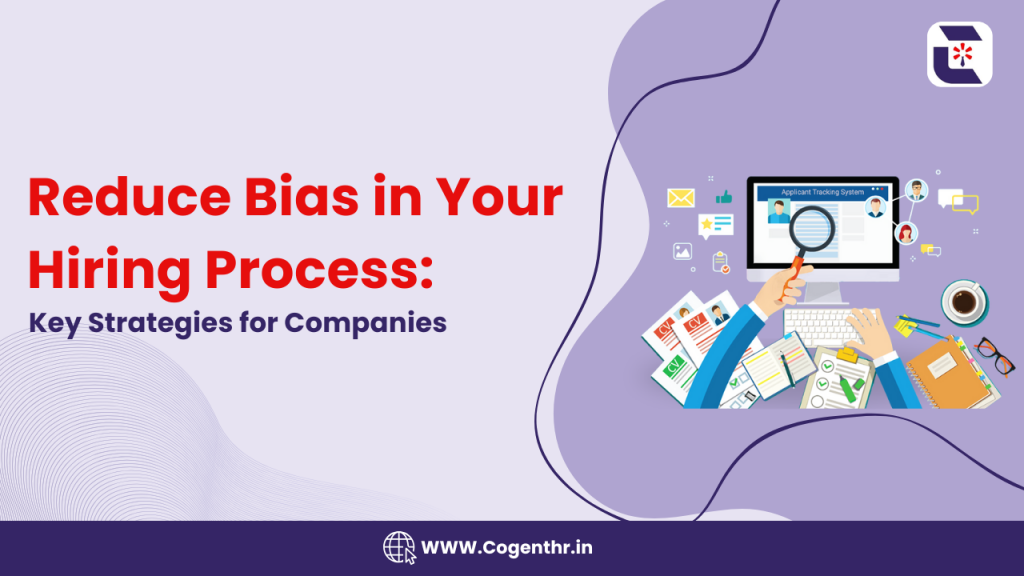Hiring the right talent is crucial for any company’s success. However, unconscious bias in recruitment can lead to missed opportunities, lack of diversity, and potential legal issues. Bias can unconsciously influence decisions, leading companies to favor candidates based on irrelevant factors such as gender, ethnicity, or educational background. Addressing bias is not just a moral obligation but also a business necessity, as diverse teams drive innovation and profitability.
In this article, we explore key strategies to reduce hiring bias and build a fair, transparent recruitment process. Implementing these techniques will ensure that hiring is based on skills, experience, and cultural fit rather than unconscious preferences.

Understanding Hiring Bias
What is Hiring Bias? Hiring bias occurs when recruiters and hiring managers make decisions based on unconscious stereotypes rather than objective qualifications. Common types of hiring bias include:
- Affinity Bias: Favoring candidates with similar backgrounds or interests.
- Confirmation Bias: Seeking information that confirms preconceived notions about candidates.
- Gender and Racial Bias: Preferring candidates based on gender or ethnicity.
- Halo Effect: Overemphasizing a single positive trait while overlooking other qualifications.
Impact of Hiring Bias Studies show that bias negatively affects workplace diversity, limits creativity, and reduces overall business performance. A McKinsey report highlights that diverse teams outperform homogeneous ones by 36% in profitability. Eliminating hiring bias can lead to a more inclusive workplace, increased employee satisfaction, and better decision-making.
Key Strategies to Reduce Hiring Bias
1. Standardized Job Descriptions & Requirements
A well-structured job description can set the stage for unbiased hiring. To ensure inclusivity:
- Use gender-neutral language to attract a diverse talent pool.
- Focus on skills and competencies rather than unnecessary credentials.
- Avoid exclusive jargon that may alienate certain groups.
For an example of inclusive job descriptions, check out our recruitment software guide.
2. Blind Resume Screening
Many companies are adopting blind hiring to minimize bias in resume screening. This involves:
- Removing candidates’ names, gender, and photos from resumes.
- Evaluating applicants purely based on skills and experience.
- Using Applicant Tracking Systems (ATS) like Cogent HR (www.cogenthr.in) to automate screening based on objective parameters.
3. Structured Interviews & Objective Assessments
Unstructured interviews often lead to bias because hiring managers rely on instinct rather than data. Instead, companies should:
- Use standardized questions for all candidates.
- Score responses based on predefined criteria.
- Implement skill-based assessments to measure capabilities objectively.
4. Diverse Hiring Panels
Including a mix of people in the interview panel helps balance perspectives. Benefits of diverse hiring panels:
- Mitigates individual biases by incorporating multiple viewpoints.
- Encourages fair evaluation of candidates from different backgrounds.
- Improves decision-making by fostering collaboration.
5. Leveraging Recruitment Technology
Modern recruitment software can help automate and standardize hiring, reducing human bias. AI-driven tools, when used correctly, can:
- Screen resumes based on predefined metrics.
- Reduce human error in shortlisting.
- Improve efficiency in job matching and candidate evaluation.
Read how companies are using AI to improve hiring outcomes on Quora.
6. Encouraging Diversity in Talent Sourcing
To widen the talent pool, companies should:
- Partner with diverse job boards and community organizations.
- Actively recruit from underrepresented groups.
- Highlight inclusive workplace policies to attract a broader range of applicants.
7. Bias Awareness & Training Programs
Training hiring teams on unconscious bias is critical for long-term change. Effective bias training includes:
- Workshops and e-learning programs to educate recruiters.
- Practical exercises that highlight real-world biases.
- Case studies showcasing the impact of fair hiring.
Research shows that companies investing in bias training see improved diversity and reduced hiring disparities. Learn more about bias mitigation strategies from industry experts on Quora.
The Role of Technology in Fair Hiring
With advancements in HR technology, reducing bias has become more manageable. Features of Cogent HR’s recruitment software include:
- Automated Resume Screening: Filters candidates based on skills, not personal details.
- Assessment Integration: Allows employers to set objective skill tests.
- Interview Scheduling Automation: Ensures fairness by standardizing interview timing and notifications.
Visit Cogent HR to explore how technology can streamline fair hiring.
Measuring and Improving Your Hiring Process
Tracking hiring metrics is essential for continuous improvement. Companies should:
- Analyze diversity ratios at different recruitment stages.
- Monitor hiring trends to identify potential biases.
- Gather candidate feedback to refine processes.
Using HR analytics, businesses can adjust their strategies for greater inclusivity and efficiency.

Conclusion
Reducing hiring bias is a long-term commitment that requires structured strategies and technological support. By implementing blind screening, structured interviews, diverse hiring panels, and AI-driven tools, companies can create a more inclusive and effective hiring process.
Start transforming your recruitment strategy today with Cogent HR—your partner in fair, efficient, and bias-free hiring!